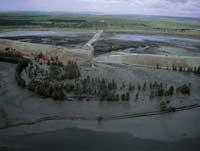Clean before returning to the river
2000/06/01 Carton Virto, Eider - Elhuyar Zientzia Iturria: Elhuyar aldizkaria
It does not occur to us that the costume that his friend left us for the carnival becomes dirty. We educate ourselves to take good care of things and return to the same state in which we collect them and so do. Thus, the friend does not get angry and, in addition, next year we will have what suit. We are learning to use water in the same way: use it, clean it and return it to the river.
However, cleaning the water used at home or in the workshop is more difficult than washing the carnival costume. The paper industry and the one that manufactures canned cans does not pollute the water in the same way. The first generates chemical contamination and the second organic contamination. Each type of industry requires a purification system suitable to its nature. The explanation of all would take time to appear and, therefore, we will only mention the main corpses, although we leave several things on the way. However, due to its more general nature, we will first refer to urban wastewater treatment.
Urban wastewater
The main impurities of urban wastewater are minerals and organic matter, transported in suspension or dissolution. The most important characteristic of urban wastewater is its biodegradability, that is, its cleaning by biological treatments. However, before performing these biological treatments, there are other processes to follow:
- Physical purification (pretreatment): the function of physical purification is to remove the transported solids. These solids are of various sizes and nature and are divided into two steps. In the first place, the larger ones are removed by an iron grate, and later, by means of a first decanting, separating the suspended sedimentable matter from the floating matter. The removal of all these solid waste is very important as solids can damage post-treatment.
- Physical-chemical purification (first treatment): water is collected in large circular tanks where decantation, flocculation, neutralization and filtration is performed. The purpose of this treatment is to separate suspended particles from water that cannot be removed by pretreatment. To do this, flocculants are added or pH is modified so that the suspended matter meets and deepens.
- Biological purification (secondary treatment): used to completely break down the organic matter that can contain water. The procedures can be of all kinds: activated sludge, bacterial filters, ventilated ponds or stabilization rafts, but all have the same function: decomposition of the organic matter dissolved in the water, that is, eating.
- Sludge treatment: sludge from decantation or biological digestion is very liquid and of little value, but must be treated before being poured into the environment. Otherwise, they can become sources of contamination. The sludge stabilizes and thickens first and then dehydrates. Some can be used as fertilizer or fuel, if not poured or incinerated.
The debuggers in our environment can be similar to those mentioned above, simpler or more complex. The desired degree of purification and the specific characteristics of wastewater determine the operation of the treatment plant. Wastewater is sometimes subjected to a third treatment to remove remaining organic compounds and dissolved salts. For this purpose adsortions, ion exchange or reverse osmosis are used, but because they are expensive techniques, their use is very reduced in scrubbers. In general a pretreatment and a first and second treatment of urban wastewater is performed.
Industry and agriculture
Industrial wastewater is of the type of industrial activity. However, the pollution generated by the industry in the water is punctual and resolved with a specific treatment plant for each type of industry. The agricultural and food industries generate high organic pollution and their wastewater is mainly purified by biological treatments. These waters have a treatment similar to that described for urban wastewater.
The paper industry, for its part, generates a large amount of waste that does not dissolve in the water, such as the fibers lost in the manufacturing process and components that improve the quality of the paper (calcium carbonate, silica, starch...). Therefore, the wastewater generated by this activity is cleaned by physical-chemical purification, that is, by flocculation/decanting cycles. The main pollutants are hydrocarbons in refineries and in the oil industry. Along with them, wastewater poured includes organic matter, acids, sulfur compounds and suspended matter. All this matter is separated by first decanting and then flocculation. Subsequently, biological purification can be performed, but water cannot contain metals or sulphides. The aforementioned debugging process is logically valid for controlled discharges. Unfortunately, oil pollutes more by accidents or by the use of by-products.
Each industrial activity has a specific purification method, but in general they are combinations of the methods mentioned for urban wastewater. Since the source of contamination is known and geographically punctual, it is enough to use the debugger to solve the problem. In agriculture, however, the source of pollution is known but widespread geographically. Therefore, it is more difficult to cope with pollution caused by agriculture, since pollutants are not incorporated into rivers in a specific place, but dispersed.
However, there are some ways to combat pollution caused by agriculture. One of them can be the riverside forest. Trees absorb fertilizers and pesticides spilled by agriculture and incorporate them into their biological cycles (use them as food) and contaminants do not reach rivers. The implementation of this type of forest has shown its effectiveness. Otherwise, the river is, at least in part, able to consume and dilute these pollutants. However, agriculture in the Basque Country does not produce extreme pollution. Industrial and domestic wastewater are really worrying. Many times measures have been taken, but still remains to be done.

Gai honi buruzko eduki gehiago
Elhuyarrek garatutako teknologia





